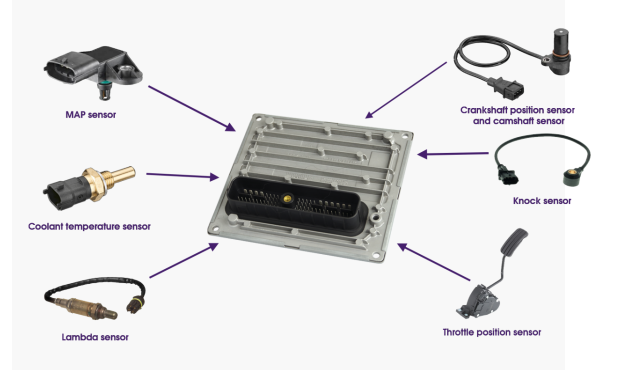Input for the ECU

To control the fuel injection, the processors in the ECU will have to be put to work. For this purpose the ECU receives information from numerous sensors. It is too much to discuss all these sensors. Therefore we will discuss below some of the most important sensors that provide input to the engine control unit.

MAP-sensor
The Manifold Absolute Pressure Sensor (MAP sensor) is used in the electronic system of an internal combustion engine. The MAP sensor provides information about the pressure in the intake manifold. This information is used to calculate the air density and the air mass ratio. Coolant temperature sensor What the coolant temperature sensor does, of course, speaks for itself. This sensor can also supply data for, for example, the electric fans or the coolant temperature on the instrument panel.
Coolant temperature sensor
What the coolant temperature sensor does, of course, speaks for itself. This sensor can also supply data for, for example, the electric fans or the coolant temperature on the instrument panel.
Lambda-sensor
The lambda sensor is a sensor also known as the oxygen sensor (O2-sensor). This sensor literally measures the amount of oxygen in the exhaust gases.
Crankshaft position sensor and camshaft sensor
The crankshaft position sensor is an electronic component found in both petrol and diesel engines. The crankshaft position sensor can also be used in combination with a camshaft sensor to measure the relationship between the pistons and valves in the engine, which is especially important in engines with variable valve timing.
This method is also used to ‘synchronize’ a four-stroke engine at start-up, so that the ECU knows when to inject the fuel. The crankshaft position sensor is often used as a source to measure the engine speed. So you can imagine that a problem with this sensor has a direct effect on the overall operation of the fuel injection system.
Knock sensor
The knock sensor measures when detonation occurs: the moment when petrol ignites too early and on its own. The blow (or knock) caused by this is detected by the sensor and immediately passed on to the ECU. The self-ignition of petrol can cause considerable engine damage, so the unit needs to adjust some things immediately. Usually in this situation the injection moment is adjusted.
Throttle position sensor
This sensor is used to determine the position of the accelerator pedal. When the accelerator pedal is pressed deeper, the amount of air and fuel sent to the engine will of course also increase.
From input to output
In addition to the direct sensor signals received by an ECU, a lot of information is also received via the CAN network. With all this input, it is important that the ECU unit knows what information is important at that moment and can take action on it. The CAN filter plays an important role in this. The CAN-filter separates, as the name suggests, the important from the less important information and sends it to the processor of the ECU. In this processor the input information is converted to output information after numerous calculations.
Output of the ECU
The generated output information will also have to be sent to different parts in the car. Which information flows, depends very much on the type of car. In cars with a turbo-injection engine, for example, it is quite possible that the ECU transmits information to the turboactuator via the CAN network.
